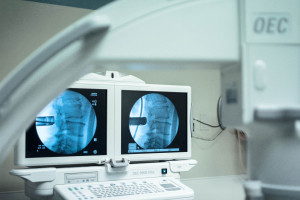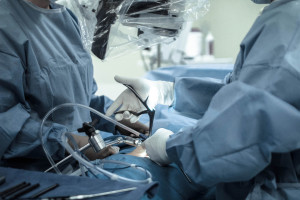


Microdiscectomy
A microdiscectomy, or a microdecompression spine surgery, is a procedure in which, to relieve the impingement of a nerve and allow it space to heal, the surgeon removes a section of the bone covering the nerve root or disc material under the root. It is one of the most common procedures performed by spine surgeons. This procedure is commonly performed to repair a herniated disc, which occurs when an intervertebral disc has fragmented and is pressing on spinal nerves or the spinal cord, or when an intact disc is bulging or protruding in such a way that puts pressure on spinal nerves or the spinal cord. Your doctor may suggest a microdiscectomy if you have severe leg pain, numbness, or weakness that hinders normal activities, and if your symptoms do not improve after at least four weeks of nonsurgical treatment.
Microscectomy versus Discectomy
Microdiscectomies serve the same purpose as discectomies, which traditionally require a large incision and can cause significant muscle damage and a long, painful recovery. However, a microdiscectomy is a minimally invasive procedure in which the surgeon makes very small incisions and uses special instruments and visualization tools, reducing the need to cut through back muscles and resulting in a faster and less painful recovery.

The Procedure
When a patient undergoes a microdiscectomy, he or she is typically put under general anesthesia, (meaning that the patient is asleep and feels no pain) or local anesthesia (meaning the patient is awake during the procedure but the surgical area is numb.) The patient lies prone on the padded operating table to allow the surgeon to access his or her spine. In one of a few methods of performing a microdiscectomy, a half-inch to one-inch incision is made and a wire is inserted until it makes contact with the spine. Dilators are used to open the muscle, using the wire as a guide, until the incision is nickel-sized. The surgeon performs the microdiscectomy through this opening with the help of a retractor that holds back the muscle and an endoscope or surgical microscope that allows him or her to see the spine. Fragments of bone and disc material are removed via the refractor if necessary, and any pinched nerves are repositioned. The wound is irrigated with antibiotics before the incision is closed, and stiches are used to hold the tissue together and promote healing. The success rate of microdiscectomies is 90% to 95%, with most complications occurring within the three months immediately following the procedure. Revision microdiscectomies used to fix such complications have a slightly lower success rate of 80% to 85%.
